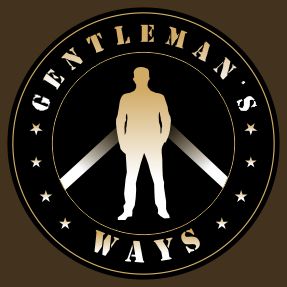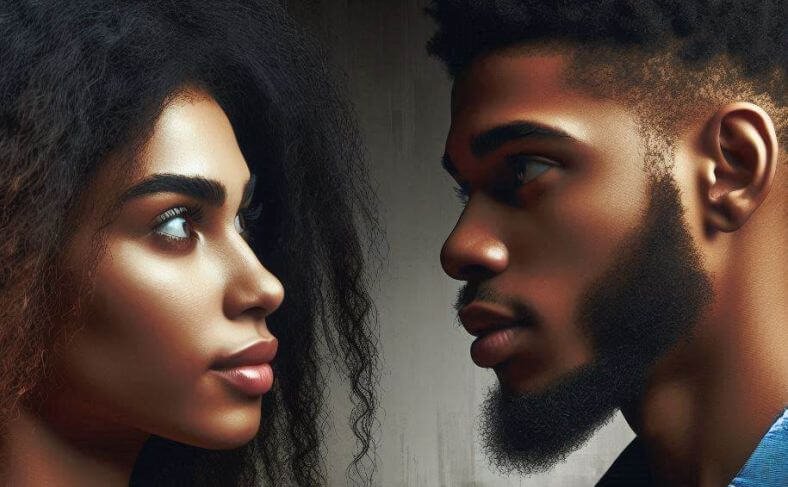Eye contact etiquette is an important nonverbal communication tool, revealing confidence, sincerity, and engagement in both personal and professional settings.
As one of the etiquette and manners to master, eye contact shows confidence, sincerity, and engagement, playing an important role in conversations, both in personal and professional settings.
Understanding the rules of eye contact and using them in interactions can promote your communication skills, and deeper connections, and leave a lasting impression.
Every gentleman, and of course every other person who loves to have effective communication and make great first impressions should master eye contact etiquette to communicate like a pro.
Key Takeaways
- Eye contact conveys confidence and sincerity, demonstrating engagement and attentiveness.
- Mastering eye contact builds trust by signaling honesty and respect.
- Adjust eye contact based on context, maintaining more in professional settings.
- Digital eye contact requires adaptation, with direct camera gaze simulating face-to-face interaction.
You might want to pin the image below.
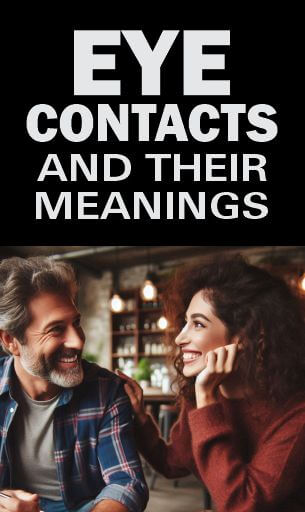
Table of Contents
- Key Takeaways
- What is Eye Contact?
- Why Every Gentleman Should Be A Master in Eye Contacts
- Why Eye Contact Etiquette Matters
- Types of Eye Contacts and What They Reveal
- Tips for Maintaining Proper Eye Contact
- Eye Contact Etiquette in Social Settings
- Overcoming Challenges with Eye Contact
- Eye Contact as a Sign of Respect
- Eye Contact Etiquette in the Digital Age
- What is Good Eye Contact?
- What Does Prolonged Eye Contact Mean?
- What Does Avoiding Contact Mean?
- What Does Intense Eye Contact Signify?
- What Does Deep Eye Contact from a Man Mean?
- Final Word from Gentsways
- Frequently Asked Questions
What is Eye Contact?
Eye contact is a nonverbal communication achieved by gazing directly into another’s eye and establishing a visual connection during communication revealing interests, agreeableness, and attention, or confidence, encouraging emotional connection.
While communication with the eyes can be learned and used, they are hardwired into human DNA and driven by human instincts.
Just like other instinctive behaviors, they are packed with meanings and reveal emotions and state of mind.
Why Every Gentleman Should Be A Master in Eye Contacts
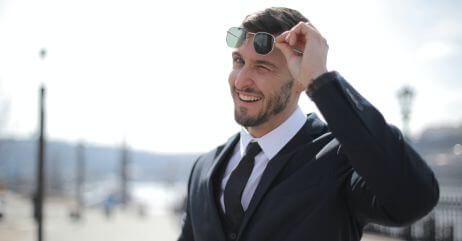
Every gentleman should master eye contact etiquette because it is a key component of effective communication that conveys confidence, sincerity, and engagement.
Gentlemen should be the custodian of etiquette, including eye contact etiquette to set precedence on how it should be done.
Also, gentlemen should convey meaning away from verbal communication by employing eye contact and other nonverbal, body language communication.
It helps to express emotions and intentions clearly, enhancing the overall impact of conversations.
Also, mastering eye contact can differentiate a gentleman in social situations, allowing him to command attention and leave a lasting impression.
By honing this skill, gentlemen can improve their interpersonal relationships and navigate various social dynamics with greater ease and poise.
Related: Gift-Giving Etiquette for Gentlemen
Why Eye Contact Etiquette Matters
Eye contact etiquette is important for the following reasons:
1. Promotes Professional Presence, Engagement, and Attentiveness: Maintaining appropriate gaze in professional settings shows you are interested and paying attention, listening, and engaging with the communication.
2. Building Trust and Rapport: Eye contact is essential for building trust and rapport. Consistent, relaxed eye contact that is not an uncomfortable stare, indicates sincerity and honesty, promoting mutual understanding and respect.
3. Conveying Confidence and Respect: A steady gaze conveys confidence and respect, showcasing self-assurance and assertiveness.
Related: Gentlemen’s Guide to Wine Etiquette
Types of Eye Contacts and What They Reveal

Of course, there are many types of eye contact depending on the meaning they convey and the duration.
Let’s take a closer look:
1. Direct Eye Contact and What it Indicates
Direct eye contact is looking your communication partner straight in the eyes without looking away. It indicates confidence, sincerity, and attentiveness.
Maintaining direct eye contact signals engagement and honesty, establishing trust and rapport, particularly in professional settings.
It also conveys confidence and assertiveness, making it effective in interviews, presentations, and leadership roles.
However, excessive eye contact can be perceived as aggressive or confrontational, so it’s essential to balance it with other non-verbal cues to avoid intimidating others.
2. Glancing Eye Contact and its Meaning
This is a quick, intermittent eye movement that is predominant in casual conversations or when interacting with acquaintances. It indicates relaxation and interest without overwhelming the other person.
However, shy or people who are battling with anxiety may use it to avoid prolonged gaze, indicating discomfort.
In group situations, it helps maintain interaction without creating a charged atmosphere.
3. Avoidant Eye Contact and its Indications
Avoidant eye contact is a conscious and deliberate avoidance of eye contact because of discomfort or shyness.
It may also mean disinterest in the conversation and can also be used to avoid conflict in charged situations.
Also, in many cultures, an avoidant gaze is a mark of respect, especially when communicating with elders or superiors.
4. Staring Eye Contact and What it Means
Staring is another type of eye contact that is achieved by prolonged eye contact that can be perceived as intimidating or aggressive, making others uncomfortable.
However, it may also mean undivided focus or interest in the conversation but with other supporting body language like nodding or facial expression to avoid misinterpretation.
5. Fleeting Eye Contact Meaning
Fleeting eye contact is a very brief glance in quick succession that indicates hesitation or confusion in a conversation.
It may also indicate an absence of confidence or the presence of self-consciousness. It can be a block for building rapport when the conversation relaxes.
6. Mutual Eye Contact and What it Indicates
Mutual eye contact happens when both communication partners make and hold eye contact simultaneously.
This kind of eye contact encourages a sense of connection and understanding, which is often takes place in intimate conversations.
It promotes empathy and emotional connection between the people involved.
7. Furtive or Secret Eye Contact and the Meaning
Furtive eye contact involves quick, secretive glances used to observe without drawing attention.
It may indicate curiosity or caution, as the person discreetly gathers information.
This type of gaze is often employed in situations where someone wants to avoid detection, such as during surveillance or covert observations.
8. Ogling Eye Contact and What it Reveals
An ogling glance is a prolonged and intense look directed at someone, usually with obvious sexual interest or attraction.
It usually conveys a flirtatious or provocative intent, suggesting a strong desire to engage with the person being observed.
This type of glance can be perceived as inappropriate or intrusive, depending on the context and the relationship between the individuals involved.
Tips for Maintaining Proper Eye Contact

Maintaining proper gaze must be according to, and suits the situation for effective interactions.
To achieve the right balance, aim for 50-70% during conversations, breaking it occasionally to avoid staring.
Adjust your gazes based on cultural norms and the comfort level of others.
In professional settings, consistent eye contact is expected, while social situations may require more flexibility to gauge comfort.
To maintain eye contact comfortably, try the following techniques:
Soften your gaze: Instead of staring intensely, adopt a relaxed and gentle gaze. This helps create a comfortable and approachable atmosphere.
Use the triangle technique: Focus on alternating between the person’s left eye, right eye, and mouth. This gives the impression of maintaining eye contact while reducing any discomfort.
Take breaks: Briefly break eye contact by looking away or down, especially during natural pauses in the conversation. This prevents the interaction from becoming too intense or overwhelming.
Master the Art of Active Listening: Participate in active listening through nods, smiles, and suitable responses. This shows that you are fully present and attentive, even when not maintaining direct eye contact.
Related: Fashion Guideline for Gentlemen
Eye Contact Etiquette in Social Settings
Here are ways you can make appropriate gaze etiquette in social interactions:
Eye Contact in Conversations
Proper gaze in conversations involves looking directly into the other person’s eyes, but not in a staring or intense manner.
It is important to strike a balance by occasionally looking away to avoid being too intense or intimidating. This allows for natural breaks to gather your thoughts or show respect when the other person is speaking.
Eye Contact in Networking and Professional Events
Eye contact in networking and professional events is essential to make a positive impression and build connections as a gentleman.
When engaging with others in these settings, looking them in the eyes shows confidence, professionalism, and a genuine interest in the conversation.
Maintaining appropriate eye contact during networking events helps create a sense of rapport and can make others feel valued and heard.
However, it is also vital to respect personal boundaries and not overdo gazes, as it may come across as invasive or aggressive.
A gentleman should always know where and when there is a balance.
Recommended: Phone Etiquette Every Gentleman Should Master
Overcoming Challenges with Eye Contact

You can overcome challenges with eye contact by practicing and implementing certain strategies.
Let’s take a better look:
Overcoming Nervousness or Shyness
Nervousness or shyness makes it difficult for you to sustain a good gaze that can convey a message. You either avoid gazes, look down, or behave awkwardly, indicating shyness.
Here are tips to overcome this:
Gradual exposure: Start by making eye contact with people you feel comfortable with, such as close friends or family members. Gradually increase the difficulty level by making eye contact with acquaintances and strangers.
Methods for Relaxation: Engage in deep breathing exercises or meditation to alleviate nervousness before engaging in eye contact. This can help reduce anxiety and promote a sense of calmness.
Empowering Self-Dialogue: Reinforce your self-value and abilities through positive self-talk. Substituting pessimistic thoughts with affirming statements to enhance your confidence.
Focus on the conversation: Instead of fixating on maintaining eye contact, shift your attention to actively listening and engaging in the conversation. This can help distract from any nervousness or shyness.
Handling Intimidating Eye Contact
There are people with gimlet eyes who can stare at you and you begin to wonder if there’s something to it. They can bore a hole in your life with their stares.
Here are some tips to overcome such a situation:
Maintain composure: Stay calm and composed when faced with an intimidating stare. Avoid showing signs of discomfort or fear, as this may encourage further intimidation.
Mirror their behavior: If someone uses an intense stare to assert dominance, you can respond by matching their stare level. This shows that you are not intimidated and can help establish a sense of equality.
Use assertive body language: Stand tall, maintain good posture, and exude confidence through your body language. This can help counteract any intimidation you may feel from intense stares.
Practice assertive communication: Respond confidently and assertively when engaging in conversation. This can help establish your presence and reduce the impact of intimidating gazes.
Related: Men’s Etiquette for RSVP
Addressing Cultural Misinterpretations
As a socially discerning person which I assume you are, you should be able to understand that culture is very important, especially as it concerns interactions. Some cultures have their etiquette about eye contact and you should find out to know.
Here are ways to go about that:
Educate yourself: Familiarize yourself with the cultural norms and practices regarding eye contact in different cultures. This will help you understand and respect the variations in eye contact etiquette.
Adapt to the cultural context: When interacting with individuals from different cultures, observe their behavior and adjust your gaze accordingly. If unsure, it is acceptable to politely ask about their cultural norms regarding eye contact.
Be open to communication: If there is a misunderstanding or misinterpretation due to cultural differences, be open to discussing it. Approach the situation with curiosity and a willingness to learn from each other’s perspectives.
Related: Etiquette for Personal Space
Related: Gentlemen’s Etiquette for Hand-kissing
Eye Contact as a Sign of Respect
Eye contact can be used to convey respect in many cultures and is universally recognized as a way to indicate attentiveness and engagement, as mentioned above.
Respectful eye contact involves maintaining appropriate and consistent gaze during a conversation without staring or looking away excessively.
It is about focusing on the person you are communicating with, acknowledging their presence, and conveying interest and attentiveness.
Related: Toasting Etiquette for Gentlemen
Eye Contact Etiquette in the Digital Age
In the digital age, where virtual communication has become the norm, etiquette regarding eye contact has also evolved.
While traditional face-to-face interactions offer natural opportunities for eye contact, it becomes more challenging to maintain eye contact in virtual settings.
However, understanding and practicing eye contact etiquette in digital interactions remains essential for effective communication.
Let’s discuss it:
Eye Contact in Video Calls and Online Meetings
In video calls and online meetings, maintaining eye contact helps to encourage engagement and attentiveness by the gentleman.
Here are some key points to consider:
Look at the camera: Staring directly into the camera lens replicates maintaining gaze in physical conversations. It helps create a sense of connection with the person you are communicating with.
Limit distractions: Minimize distractions around you to concentrate on the video call. Avoid looking elsewhere, constantly checking your smartphone, or engaging in unrelated activities. Focus on the person or people on the screen.
Non-verbal cues: Apart from gazing, pay attention to your non-verbal cues. Express interest by nodding, smiling, or displaying appropriate facial expressions. This shows active participation, even if you can’t maintain constant eye contact.
Adjust Screen Layout: Place participants’ video feeds close to the camera to use peripheral vision for reactions.
Use Tools for Better Positioning: Employ teleprompters, hanging webcams, or mounts to align the camera with participants’ images.
Practice Eye Contact Techniques: Visualize the person you’re speaking to on the camera lens to maintain connection.
Be Mindful of Cultural Norms: Adapt your eye contact approach based on the participants’ cultural backgrounds.
Related: Embarking on a Journey the Gentleman’s Way
What is Good Eye Contact?
Good eye contact is effective communication, conveying confidence, engagement, and sincerity.
It involves maintaining appropriate eye contact during conversations, typically around 50-70% of the time, to show attentiveness without overwhelming the other person.
Good eye contact fosters connection and trust, allowing for deeper understanding and empathy.
It varies by context; in professional settings, consistent eye contact is essential, while in social situations, it may be more relaxed.
Related: Gentleman’s Napkin Etiquette
What Does Prolonged Eye Contact Mean?
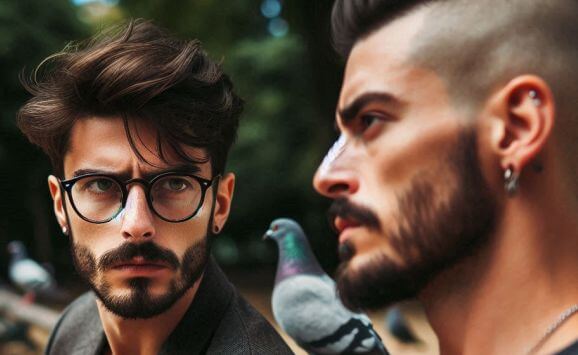
Prolonged eye contact signifies strong interest, attraction, or emotional connection between people.
It can enhance intimacy and empathy, encouraging a deeper understanding during conversations.
However, excessive prolonged eye contact may also be perceived as confrontational or aggressive, potentially making others uncomfortable.
Therefore, it is essential to balance prolonged eye contact with awareness of social cues and context to ensure effective communication.
What Does Avoiding Contact Mean?
Avoiding eye contact can have various meanings depending on the context and individual.
It may indicate shyness, discomfort, or lack of confidence, suggesting the person is not fully engaged in the conversation.
In some cases, people use avoidance of eye contact to steer clear of conflict or confrontation, especially in tense situations.
Culturally, avoiding eye contact can also be a sign of respect or deference, particularly when speaking to authority figures.
Understanding these nuances is crucial to prevent misunderstandings and enhance communication.
However, it is important to note that prolonged avoidance of eye contact may be a sign of underlying issues that require attention.
What Does Intense Eye Contact Signify?
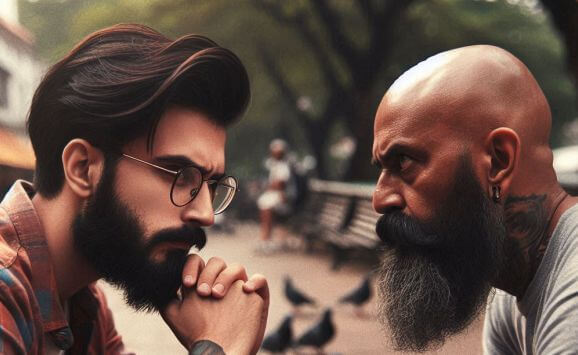
Intense eye contact is a prolonged and focused gaze between individuals, often conveying strong emotions such as attraction, interest, or deep engagement.
It can create a sense of intimacy and connection, encouraging communication and understanding.
In social interactions, intense eye contact may signal confidence and assertiveness, making the speaker appear more credible and trustworthy.
However, it can also be perceived as intimidating or confrontational if not reciprocated or if the context is inappropriate.
Understanding the dynamics of intense gaze is essential for navigating social and professional situations effectively, ensuring that it fosters positive interactions rather than discomfort.
What Does Deep Eye Contact from a Man Mean?
Deep eye contact from a man often signifies attraction and interest. When a man locks eyes with someone and maintains that gaze, it typically indicates he is engaged and emotionally invested in the interaction.
This type of eye contact can encourage a sense of intimacy and connection, suggesting he values the conversation and the person he is looking at.
However, it’s essential to consider context, as deep eye contact can also be perceived as intense or confrontational if not reciprocated.
Final Word from Gentsways
Mastering eye contact etiquette enhances both personal and professional interactions by conveying confidence, sincerity, and engagement.
Appropriate eye contact fosters trust and respect and helps build deeper connections.
By understanding the different types of eye contact and their meanings, individuals can navigate conversations more effectively, creating a positive impact and leaving a lasting impression.
Frequently Asked Questions
What is the 3-second rule of eye contact?
The 3-second rule of eye contact suggests maintaining eye contact for about 3 seconds before looking away, as it is considered polite and engaging.
What is the golden rule of eye contact?
The golden rule of eye contact is to maintain a balance by making eye contact without staring or avoiding it excessively, ensuring a comfortable and respectful interaction.
What does 5-second eye contact mean?
A 5-second eye contact can indicate a deeper connection or interest between individuals, often signaling a desire for further interaction or conversation.
When a man holds eye contact with a woman?
When a man holds eye contact with a woman, it can convey various meanings depending on the context, such as attraction, confidence, or simply engaging in a conversation.
References:
- Eye Contact Rules for Gentlemen
- https://www.americanexpress.com/en-us/business/trends-and-insights/articles/the-3-rules-of-eye-contact-etiquette/
- https://ahaslides.com/blog/eye-contact-in-communication/
- https://www.betterup.com/blog/why-is-eye-contact-important
- https://colinjamesmethod.com/the-4-types-of-communication/
- https://courses.lumenlearning.com/atd-tc3-management/chapter/different-types-of-communication/
Pyo Merez is a men’s lifestyle enthusiast and writer about the gentleman’s place and impact on society. Raised by a distinguished gentleman dad, he offers unique insights into how the mind of a gentleman works and how societal norms shape gentlemen’s identity and vice versa.
Through his insightful articles, Pyo taps into the depths of gentleman culture to provide perspectives on etiquette and manners in modern society.
